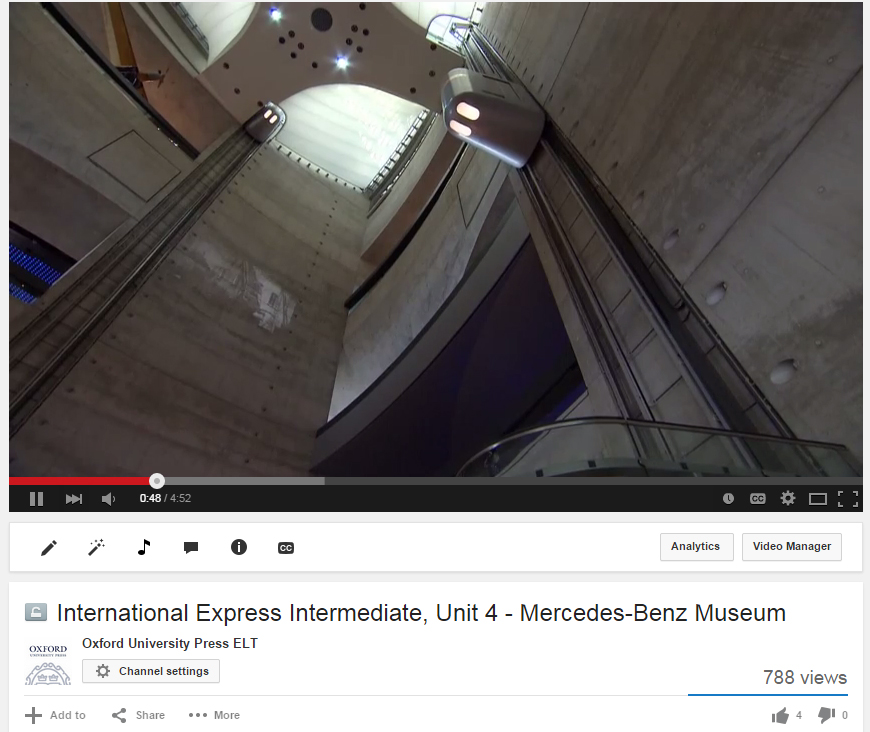 Fancy livening up your classroom with some ready-made video activities? This is the third in a series of four articles in which Keith Harding and Rachel Appleby share ideas for using the stunning new International Express video material. Each unit of the course features a video directly related to the unit topic. Here, Keith offers some ideas for using the clip from Intermediate Unit 4 – Mercedes-Benz Museum, which focuses on making comparisons.
Fancy livening up your classroom with some ready-made video activities? This is the third in a series of four articles in which Keith Harding and Rachel Appleby share ideas for using the stunning new International Express video material. Each unit of the course features a video directly related to the unit topic. Here, Keith offers some ideas for using the clip from Intermediate Unit 4 – Mercedes-Benz Museum, which focuses on making comparisons.
Before you watch
As with any listening or reading text it is important to prepare and predict, in order to maximise the learning potential from the video. Here are some ideas to get your students started before they watch the video.
1. Museums
Students in pairs/groups describe museums in their city/country, and talk about their favourite museum. Questions to ask include:
a. What do they like about their favourite museum?
b. Why is it better than other museums? (This will help to elicit practice of comparatives)
c. Do they know any unusual museums, e.g. for particular products and brands?
Plan a ‘Museum of Brands’
Elicit some top-of-the-range brands from the students, for example, Rolex, Apple, Nike, Mercedes Benz (prompt to elicit this one if necessary)
In groups, students decide what they would exhibit in a ‘Museum of Brands’ and what they would call each of the galleries.
2. Pre-teach vocabulary
This exercise is taken from the video worksheet that comes with the International Express Teacher’s Resource Book DVD. All the worksheets are also available for free here. You just need your Oxford Teacher’s Club log-in details to view them.
Vocabulary:
What do the words in bold mean?
- The story is based on a local legend.
- The prototype of the vehicle used a piston engine.
- He is a real football enthusiast. He goes to every game.
- My father collects a lot of Beatles memorabilia, like albums, posters, and concert tickets.
- Phone companies need to have cutting-edge technology to be successful.
- The documentary on deep-sea diving gave us a glimpse into life in the ocean.
- The book gives us an insight into life in South America.
While you watch
To maximise the learning opportunities, you need to set tasks for the students to focus on. Remember tasks can be graded to the level of the learners, even if the content is not. This will involve the teacher in using pause, rewind, and sound-off facilities.
3. Silent play on fast-forward
Play the whole video on fast-forward with the sound down. Students write down what they see, then compare in groups and then watch again on normal speed.
4. Recognising difficult or technical vocabulary
As you would expect, the video contains several terms relating to vehicle transport. Understanding lexical sets of technically-related vocabulary and the differences in meaning between the different items is an important skill for the professional adult learner. Play the video in sections and ask students to write down the names of any vehicle types they hear. They should identify the following:
motor car
horse-drawn carriage
automobile
limousine
convertible
roadster
sports car
rally car (‘rallying’ on the video)
Formula 1
racing car
lorry (lorries)
police car
ambulance
fire engine
Check students’ answers, and ask them to give a definition of each type.
5. Numbers and names ‘bingo’
Design a bingo card for each student with numbers and names, including ones from the video, but other distracters as well. Students tick off the numbers/names when they hear them. When they have completed a line of three (horizontal, vertical or diagonal) they shout bingo, stop the video and check.
Here are two examples:
Example 1:
| nine | 60,500 | Rolls Royce |
|---|---|---|
| Karl Benz | Daimler AG | one million euros |
| Formula 1 | Ferrari300 | SL |
Example 2:
| a million | 16,500 | Porshe |
|---|---|---|
| 1954 | seven | Mercedes Simplex |
| 13 | 300 SL | convertible |
After you watch
Follow-up tasks and activities will help to reinforce the language and will also provide the opportunity for more communicative and interactive language practice.
6. Practice vocabulary work on different forms of transport, and different brands and products
7. Conduct a survey of class members or any other accessible group (e.g. work colleagues, teachers and staff in school). Example questions could be:
a) Which museums have you visited?
b) Which is your favourite – or least favourite – and why?
c) What factors are important for you in a museum? Examples could include admission cost, interesting displays, interactive exhibits, a good cafe.
d) Use the results to plan a group outing.
8. Plan and present an idea for your own museum
a) Use the results from the survey (task 8) if available.
b) Decide the theme for your museum. For example, it could be a museum of your own life, with photographs, objects from your past and from your present working life.
c) Design the plan of the museum.
d) Present to the rest of the group.
I hope you enjoy trying out some of these activities in class!

